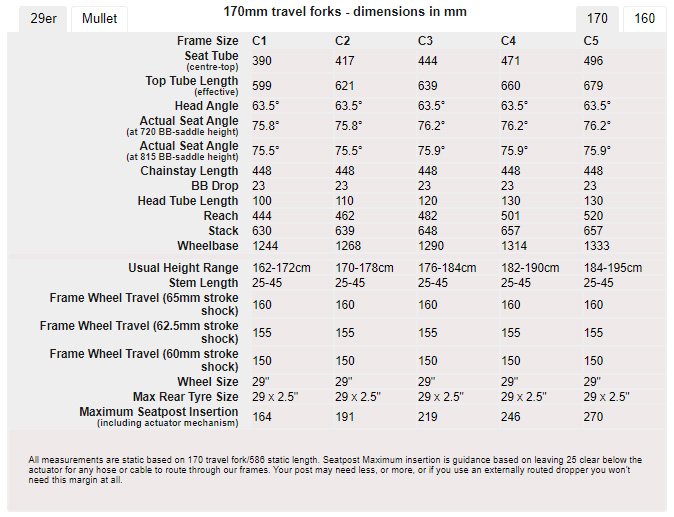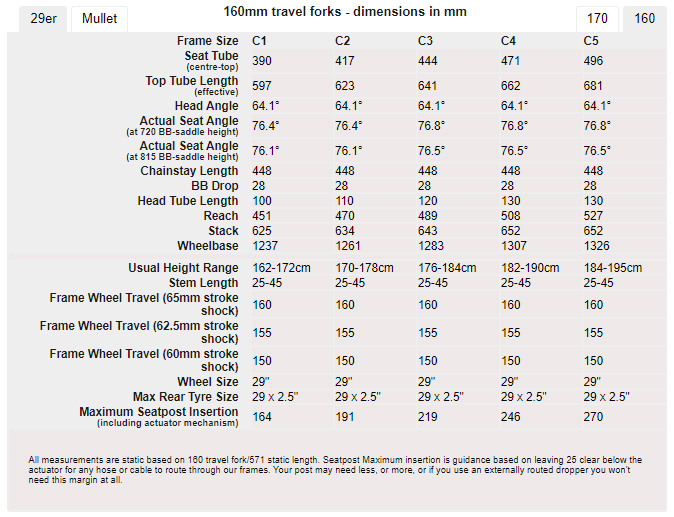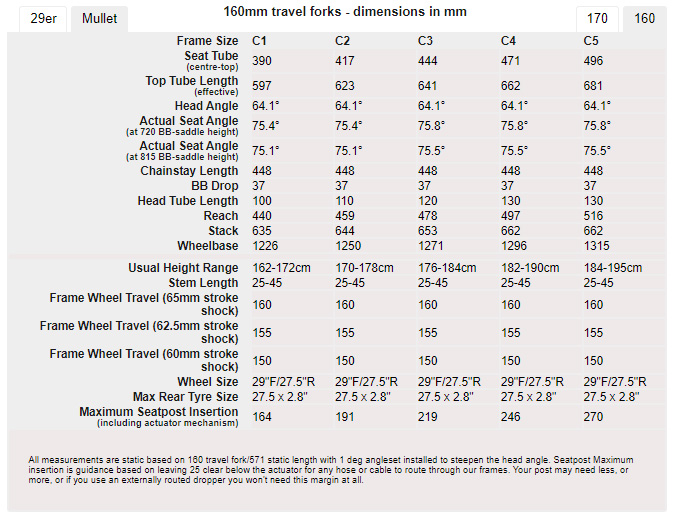Cotic RocketMAX Gen4
Wheel Size: 29’’ (29’’ front / 27.5’’ rear compatible)
Travel: 160 mm rear / 170 mm front
Geometry highlights:
- Sizes offered: C1, C2, C3, C4, C5
- Headtube angle: 63.5°
- Seat tube angle: 75.9° (at 815 mm seat height)
- Reach: 482 mm (size C3)
- Chainstay length: 448 mm
Frame material: Steel w/ aluminum chainstay
Price:
- Frame w/ RockShox Super Deluxe Select+ shock: £2,099 including VAT ($2,271 USD w/o VAT at time of publication). Shock upgrades available for an upcharge.
- Complete bikes with custom builds available; see Cotic’s online frame builder tool for details.
Blister’s Measured Weight: 36.0 lb / 16.3 kg (as tested; see below)
Test Locations: Washington and British Columbia
Reviewers:
- David Golay: 6’, 175 lbs / 183 cm, 77.9 kg
- Zack Henderson: 6’, 160 lbs / 183 cm, 72.6 kg
Test Duration: 3.5 months
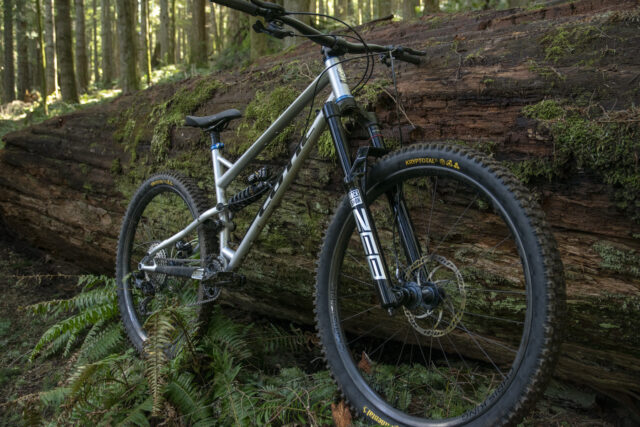
Intro
It’s apparently (accidentally) UK steel bike week here at Blister because right on the heels of publishing our full review of the Starling Murmur, I’ve also started spending time on the Cotic RocketMAX Gen4. And while the two bikes have some commonalities in terms of frame material, country of origin, and intended use, they’re quite different once you dig a little deeper.
So what’s the story with the RocketMAX, and where does it slot into the modern Enduro bike market? Let’s dive in.
The Frame
Like all of Cotic’s bikes, the RocketMAX is (mostly) made from steel, with a Reynolds 853 tubeset that Cotic developed with Reynolds specifically for their own use. The exception is the chainstay assembly, which is made from aluminum, which Cotic says makes more sense for that part, primarily to reduce weight from the forged chainstay yoke, main pivot area, and dropouts. (Check out my recent conversation with Cotic founder Cy Turner on Ep. 160 of Bikes & Big Ideas for much more on that).
The RocketMAX gets 160 mm of rear wheel travel from a 230 x 65 mm rear shock by way of Cotic’s “Droplink” suspension layout — essentially a linkage-driven single pivot with a horizontally mounted shock and a rocker link (the “droplink”) mounted to the seat tube. The rocker pivot does interrupt the seat tube and limits dropper post insertion a bit, but Cotic lists maximum seatpost insertion numbers on their geometry chart (below) to help figure out what would work. Shortening the shock stroke to reduce the travel to 155 mm (62.5 mm stroke) or 150 mm (60 mm stroke) is an option if you’re so inclined.
While the RocketMAX is primarily designed for dual 29’’ wheels, it’s also possible to run it in a mixed wheel size configuration with a 27.5’’ one in back. Cotic doesn’t make any frame changes to toggle between the two but instead recommends a +1° headset to steepen the headtube angle back up (and they spec one on RocketMAX bikes ordered as a mullet). That has a few knock-on effects to the geometry (more on those in a minute) but the option is there if you want it.

The RocketMAX features (mostly) external cable routing, with all three running on top of the downtube (secured by tidy bolt-on plastic clips), though the derailleur cable does go through the seatstay to protect it from chain slap; the brake hose remains external on top of the chainstay, so there’s no need to disconnect the hose to install or remove the brake. The RocketMAX features one set of bottle bosses on the underside of the downtube and another accessory mount underneath the top tube (which can serve as a bottle mount on the larger sizes, but there’s not enough real estate on the smaller ones). The RocketMAX uses a 31.6 mm seat tube, 44 mm straight headtube (with an external lower headset cup), and a Syntace X12 derailleur hanger. The lower two tabs of an ISCG-05 setup are included, and a direct-mount upper chainguide is featured as well.
The front triangle of the RocketMAX is made in Scotland by Five Land Bikes, with the rear triangle coming from Taiwan. Assembly happens at Cotic’s headquarters in the UK’s Peak District. The steel frame components are phosphate dipped before painting for corrosion resistance, and the graphics are masked and painted on, rather than being decals, for better durability. Cotic also offers a 30-day guarantee where you can send the bike back for a full refund if you’re not happy after the first month of ownership. And along with that, the RocketMAX includes a 5-year warranty for the original owner.

Fit & Geometry
Cotic offers the RocketMAX in five sizes, labeled C1 through C5 — roughly correlating to Small through XXL in most manufacturers’ sizing schemes. All get a 63.5° headtube angle, 448 mm chainstays, an effective seat tube angle right around 76°, and 23 mm of bottom bracket drop. Reach ranges from 444 mm to 520 mm in roughly 20 mm increments per size — comparatively tight gaps that Cotic says give riders more ability to size up or down to hit their preferred fit and ride feel as desired.
All those numbers are in the 29’’ configuration with a 170mm-travel fork; going to a mixed wheel configuration (with the +1 degree headset that Cotic recommends) keeps the headtube angle the same but slackens the seat tube by about a degree, lops ~10 mm off the reach, and increases the bottom bracket drop to 32 mm. Running a 160 mm travel fork (in either wheel size configuration) steepens the angles by about half a degree, lowers the bottom bracket by about 5 millimeters, and adds a few millimeters to the reach.
The RocketMAX has a somewhat longer than average headtube (bearing in mind that it also uses an external lower headset cup) which produces notably tall stack heights (648 mm on the size C3) which, frankly, I think makes good sense for this sort of bike. Just bear that in mind when thinking about sizing — you’re likely to run fewer headset spacers under the bar on the RocketMAX than you would on many other bikes, and the effective reach and top tube lengths are a touch longer than they would be with more spacers under the stem.
But for the most part, those are nice, fairly conventional numbers for a modern Enduro bike. If anything, the chainstays are fairly long (especially on the smaller sizes) but nothing jumps out as being all that wild. And while the seat tube number doesn’t sound super steep by modern standards, it’s worth bearing in mind that there’s very little offset to it (i.e., the actual and effective seat tube angles are nearly the same) and that Cotic publishes two effective seat tube angles, the latter of which is at a quite high seat height of 815 mm from the center of the bottom bracket to the top of the seat.
The Builds
Cotic doesn’t offer standard builds on the RocketMAX, instead allowing customers to spec out a custom build (or partial build) as desired. Cotic’s bike builder tool has some suggested packages to get you started and streamline the process for folks who want some guardrails, but you’re free to mix and match things around as desired. They also encourage folks who want something not listed in the builder, or who just want advice on how to spec out their bike, to get in touch and chat about it.
When we were planning the build for our review bike, Cy suggested doing something of a maximum-bang-for-buck build, with a Shimano SLX drivetrain and Hunt aluminum wheels, but high-end suspension and solid brakes. I was into the idea, and we wound up building up the bike as follows:
- Drivetrain: Shimano SLX
- Brakes: Magura MT5 2-finger w/ 203 mm rotors
- Fork: RockShox ZEB Ultimate (Charger 2.1 model)
- Shock: Cane Creek Double Barrel Kitsuma Coil
- Wheels: Hunt Trail Wide V2
- Dropper Post: OneUp (210 mm stroke)
With a few small upgrades (including a blue Hope headset and seat clamp) the total package comes to £4,512 ($5,570 USD at the time of publishing) — quite reasonable for an Enduro bike with top-tier suspension and solid but un-flashy everything else.

Some Questions / Things We’re Curious About
(1) How does the RocketMAX compare to the big class of ~160mm-travel Enduro bikes that we’ve been on recently?
(2) And how similar or different does the RocketMAX feel to the Starling Murmur Enduro that we just reviewed — another UK-made steel full suspension bike, but with a true single-pivot layout? The steel construction felt like a big part of what made the Murmur what it is, but will that be true of the RocketMAX as well?
Flash Review
Blister Members can read our Flash Review of the Cotic RocketMAX for our initial on-trail impressions. Become a Blister Member now to check out this and all of our Flash Reviews, plus get exclusive deals and discounts on gear, and personalized gear recommendations from us.
Bottom Line (For Now)
The Cotic RocketMAX is a bit of a rarity in the modern market, in that it’s a (mostly) steel full-suspension Enduro bike, but one with relatively conventional geometry for the class. We’ve started spending time on the RocketMAX to find out how it all adds up on the trail, so stay tuned for a full review soon.
FULL REVIEW
Cotic has been making steel full-suspension bikes for quite a while now; you should check out Ep.160 of Bikes & Big Ideas for a whole lot more on their history and design philosophy. When the RocketMAX Gen4 showed up for testing, we were pretty curious to see how it would ride — especially coming on the heels of the Starling Murmur Enduro that we’d just tested.
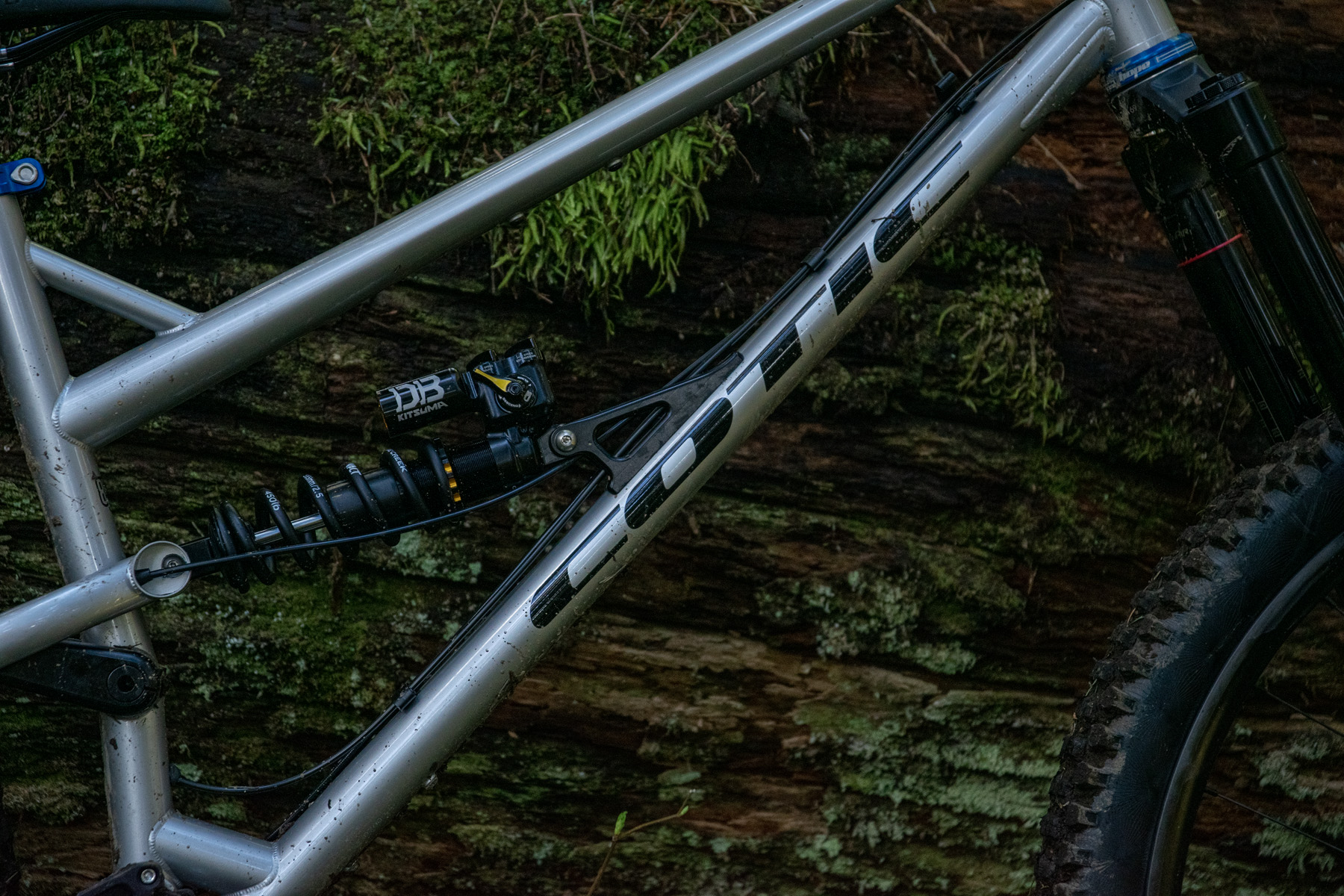
Fit & Sizing
David: I had a bigger conundrum with the sizing of the RocketMAX than I do with most review bikes when looking at the geometry charts and deciding which one to go for. Cotic’s sizing chart gives me (6’ / 183 cm tall) a one-centimeter buffer into the bands for both the C3 and C4 sizes (at the top end of the former and bottom of the latter) and that seemed about right based on my typical preferences. But having had a couple of recent Enduro bike reviews where I was similarly on the brink, sized down, and felt like I could have used a bit more room to move around on the bike, I opted for the C4 RocketMAX, and I think that was the right call.
The C4 RocketMAX is definitely a big bike — 501 mm reach, 657 mm stack, 660 mm effective top tube — but the way those numbers converge made the sizing decision less cut and dried than it is on a lot of other bikes. With the C3 frame coming in at a 482 mm reach, the C3 and C4 more or less bracket my preferred numbers for this sort of bike; the quite-tall stack height makes the effective reach longer, if anything, since I’d presumably be running fewer stem spacers than I would on a bike with a shorter stack (and therefore moving the stem backward less). While the 660 mm effective top tube on the C4 is definitely longer than I’d prefer in general, it’s also deceptively not as huge as the number would suggest, because the tall stack height of the RocketMAX means that it’s being measured at a greater height off the ground (where the seat tube angle has had more room to stretch the ETT rearward) than it would be on a bike with a shorter stack and otherwise identical numbers.
[Check out the geometry sections in our Mountain Bike Buyer’s Guide if a refresher on how those geometry numbers relate to each other would be helpful.]
Zack: On paper, the size C4 RocketMAX is quite likely the largest bike I’ve ridden. I’m typically a shoo-in with most companies’ interpretations of a size Large and generally prefer a 485 mm reach, which aligns more with the 482 mm reach of the size C3 than the 501 mm reach of the C4. Despite that preference, with my 6’ / 183 cm height and slightly longer torso, I sat right on the border of Cotic’s recommendations for the C3 and C4. Fortunately, despite an initial adjustment to the lengthy top tube, I found the imposing dimensions of the C4 to suit me better than I expected.
I’ll go into more detail on how the length of the wheelbase and cockpit affected its climbing and descending performance in the next sections, but I think that Cotic has done a nice job with its proportions on the RocketMAX. Ultimately, while I did find the standing and seated positions just a bit longer than I might prefer, the stability that came with the length was appreciated in certain situations. I did find the seat tube length to be taller than I’d like, which limited my ability to run a post beyond 185 mm drop — not a deal breaker, but I’d love more flexibility there. Additionally, the stack height had me running the stem as low as I could in order to get my preferred descending position, and I wouldn’t have minded seeing the stack dialed back a bit to give me more range of adjustment in cockpit height.
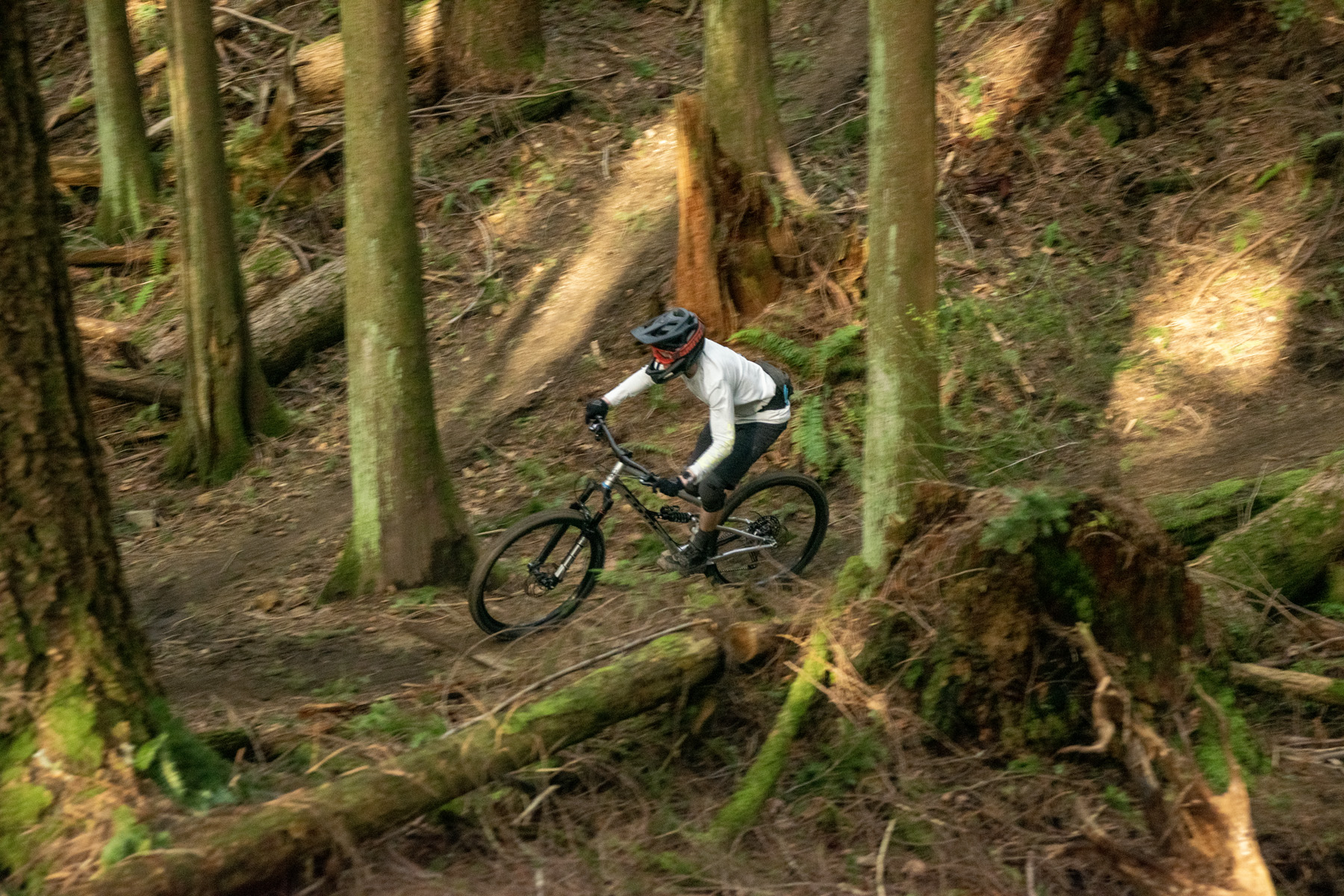
I’d have liked to try a C3 to see what changes might come to the bike’s personality, and I may have to do that sooner rather than later — the unassuming silver RocketMAX proved to be an especially impressive trail companion and one that I’d be happy to have in my own garage.
David: We’ll go deeper into the finer points of how the RocketMAX’s fit contributed to its on-trail performance in a minute, but my overall take is that the C4 RocketMAX felt great when I was standing up and descending and that I’d have preferred a slightly steeper seat tube angle (and therefore shorter effective top tube) when seated and pedaling up very steep climbs in particular, but it wasn’t a big enough issue to make me think I’d prefer the C3 overall. Folks who are worried about the long-sounding effective top tube should bear in mind the impact that the tall stack height has on that figure; people who’d prefer a more nimble feeling bike can probably size down safely (within reason) without making the seated pedaling position feel super cramped; and if you’re in doubt, Blister Members are always an email away from getting our specific advice for your particular situation.
Anyway, that’s a long-winded way of saying that (1) you really can’t boil bike fit down to just one or two numbers, (2) I think Cotic’s general sizing recommendations seem pretty on the money, and (3) that I’m glad that I sized up to the C4 RocketMAX, given how it felt on the way back down, in particular. But what goes down must first get to the top, so on that note:
Climbing
David: The RocketMAX climbs respectably well for a 160mm-travel Enduro bike, especially for folks who prioritize suspension that remains comparatively active under power and maintains especially good traction, rather than seeking the absolutely most efficient-pedaling bike at the expense of grip and compliance. The RocketMAX still offers solid pedaling efficiency, but it’s closer to the middle of the spectrum for bikes in this travel range, rather than specifically excelling on that front. There are bikes that pedal more efficiently, but just about all of them get there by firming up the suspension more under pedaling efforts and giving up some rear wheel grip and suspension compliance to get there. Compared to bikes that are on the most active, plush end of the spectrum, the RocketMAX is both more efficient and does a better job of staying up in its travel / not feeling wallow-y and unsupportive under big pedaling efforts or the sorts of weight transfers that are brought about by lofting the front wheel over ledges and the like when climbing. It’s just nicely rounded and I think will strike a solid middle ground for a lot of people who really have use for a big Enduro bike, but whose preferences when it comes to climbing performance don’t skew dramatically to one end of the spectrum or the other.
If I have any gripes with the RocketMAX’s climbing performance, it’s that I’d personally prefer a slightly steeper seat tube, especially having sized up to the C4. I wouldn’t make huge changes if it were up to me — maybe a degree on both the actual and effective angles — but tightening up the seated cockpit would, I’m pretty sure, make the pedaling position a little more comfortable for me, especially on very steep climbs where my weight is shifted more rearward and the rear suspension is sagging more. But I’m just used to steeper seat tubes in general, and was swapping back and forth between the RocketMAX and a couple of steeper-seat-tube bikes over the course of my testing, and, again, had sized up on the RocketMAX to boot. I didn’t have any trouble keeping the front wheel of the RocketMAX planted even on those steepest climbs or anything like that, and very well might feel differently if I’d opted for the C3 frame and its shorter top tube. If you’re someone who finds the most ultra-steep modern seat tube angles to have overshot the mark a little and/or are inclined to size down to keep the reach and wheelbase more manageable, the RocketMAX might well hit the mark for what you’re after.
Zack: The RocketMAX is a relatively average climber among the current crop of Enduro rigs. The seat angle is a bit slacker than what is in vogue at the moment, contributing to a relatively long-feeling cockpit when paired with the lengthy 501 mm reach. While some bikes with slightly slacker seat tubes can suffer from ponderous handling on the way up, the long 448 mm chainstays helped to center my weight as I winched up our steep climbs here in Bellingham.
As noted above, the high 657 mm stack of the RocketMAX seemed to offset some of the lengthy 660 mm effective top tube’s impact on the overall cockpit feel, helping the bike feel a bit shorter and more upright than the reach and ETT numbers would imply on their own. The bike’s length was quite noticeable on switchbacks, where the 63.5° head angle and huge wheelbase presented some awkwardness.
When it comes to pedaling performance, I found the RocketMAX to benefit from the luxury of a climb switch to firm up the otherwise active rear end. Cotic has opted to dial back anti-squat in favor of a more active rear suspension that is less impacted by chain tension, and while it offers above-average grip, it doesn’t quite measure up to some of the more efficient Enduro bikes I’ve been riding lately. It’s hardly inefficient, and I was never bothered riding the bike in the “open” setting on the rear shock. Riders who can spin smooth circles won’t be bothered, but pedal mashers may find the bike to bob a bit more than some others under power.
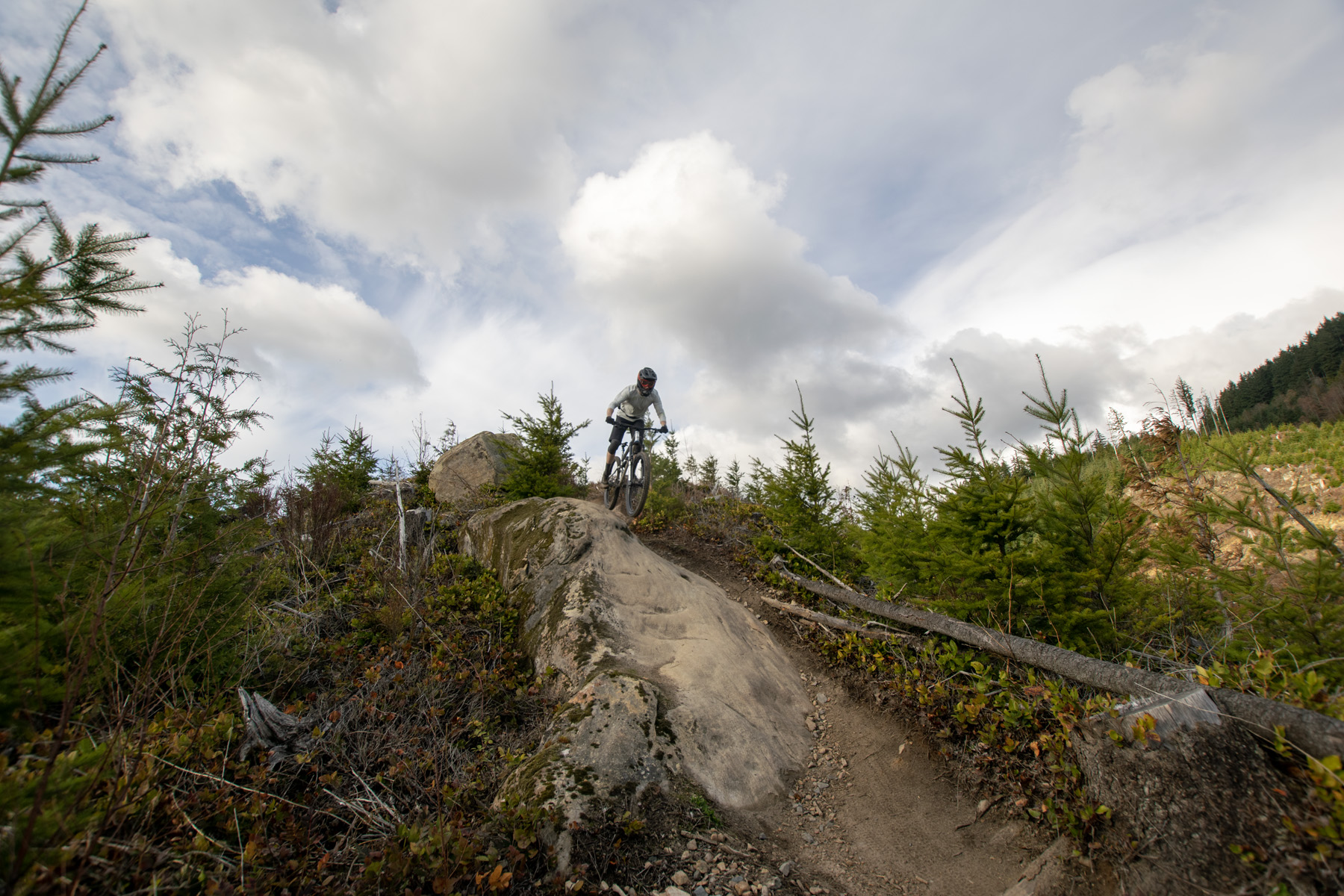
Descending
Zack: While the RocketMAX didn’t really stand out on the climbs, it really managed to measure up to its name on the way back down. “Quiet confidence” is the phrase that comes to mind to describe the Cotic, and it proved to be an unflappable companion on every ride I took it on.
I managed to ride the Cotic through shoulder season here in Bellingham, which meant the full transition from gooey mud and shiny roots to loose rock and baby powder dust. In slower, wetter conditions, the active rear suspension paired with the impressive Cane Creek Kitsuma Coil offered huge amounts of grip in combination with a giant amount of adjustment range. The tall front end lent a ton of confidence when creeping into questionably steep, rutted chutes, and the WTB Verdict front tire tracked fairly well in soft and loose conditions, even as the short knobs of the Trail Boss rear tire struggled to keep up at times. If anything, my complaint is that the rear suspension far outclassed the somewhat wooden feel of the prior-generation RockShox Zeb Ultimate.
As trails dried out and speeds picked up, the Cotic only became more impressive. The big wheelbase of the size C4 felt well balanced between the long reach and long chainstays, centering my weight nicely and promoting a tall, attacking stance. While it didn’t erase bumps like some higher-pivot designs can, the rear end of the RocketMAX continued to be unflappable, never diving into its travel or feeling harsh. The rougher and faster the trail, the more comfortable the RocketMAX felt, almost like letting a big, damp ski run the fall line on a powder / chop day.
David: I want to emphasize what Zack said here because the most standout trait of the RocketMAX for me was just how comfortable it is at speed on rougher trails. He’s right to say that it doesn’t entirely erase bigger bumps the way that, say, a well-sorted DH bike can, but the overall ride quality is truly excellent.
It feels reductive and hack-y to just attribute that to the (predominantly) steel construction — and I’ve been on steel full-suspension bikes that don’t ride anywhere close to this well — but I think it is fair to say that Cotic has really nailed the tubeset in the RocketMAX, and paired it with well-sorted suspension kinematics to seriously impressive results. The RocketMAX — both with the Cane Creek Kitsuma Coil rear shock Cotic sent it over with, and with the RockShox Super Deluxe Air that I swapped in after the Cane Creek needed a service (more on that later) — just felt nicely rounded in its suspension performance, without being way off to one end of the spectrum on any particular attribute, to the detriment of another. Small bump sensitivity is good, without feeling ultra-plush and wallowy or lacking support; there’s a nice, smooth ramp-up firmness as you get deeper in the travel; and the braking performance is neutral and intuitive, with the rear end not doing anything obtrusive under heavy braking.
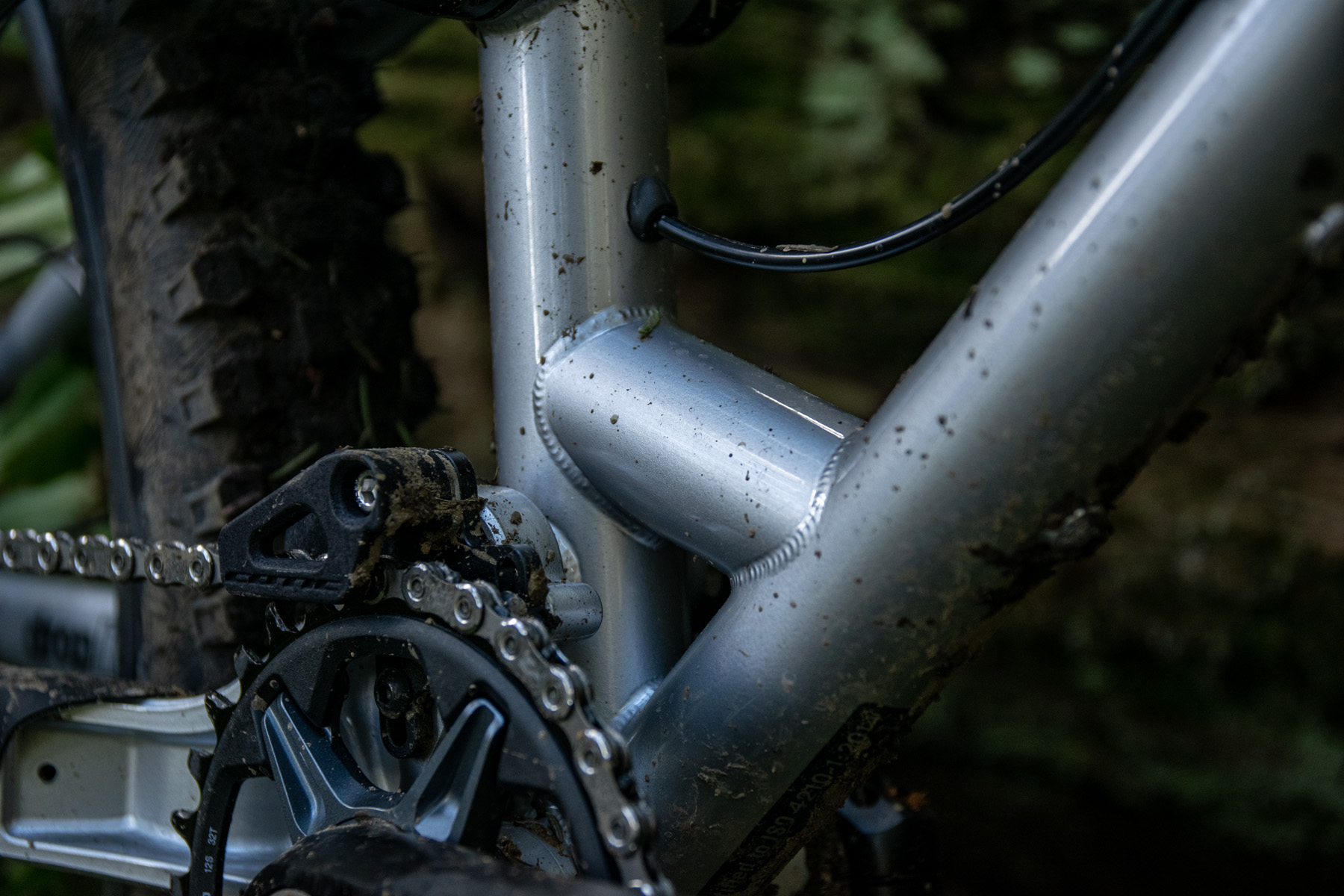
But I really think that the biggest piece of the magic is just how Cotic has dialed in the flex and ride quality of the frame. The RocketMAX just does a remarkably good job of muting out the kinds of super fine, chattery feedback that really contributes to fatigue over the course of a longer day on the bike, or even a single, long descent, and it does that without feeling notably flexy or lacking in precision. It’s excellent.
Zack: Continuing my snowsports analogy from above, in the same way that a big powder ski can feel cumbersome when taken out of its element, I found the length of the RocketMAX to be a bit less fun on flow trails. Admittedly, that really isn’t what the RocketMAX is for, but it does point to the RocketMAX erring on the side of being a more purposeful weapon than some other bikes that aim to be a quiver of one. The suspension has an energetic and supportive feel, but the sheer length makes it less versatile than some other options, which we’ll cover below in the comparisons. This is where I’d be keen to see how the shorter C3 size might fare.
I’m guessing that a lot of folks reading this review are wondering about the frame material. Folks familiar with steel frames will likely already be excited about Cotic’s use of much revered Reynolds 853 steel tubing for the front triangle in combination with an aluminum rear triangle. With my only prior experience with steel being on several high-end steel hardtails, I was excited to see how frame material might influence overall feel in a full-suspension application. I’ll be the first to admit that talking about the “feel” of a frame material is hardly scientific, but coming from the big, stiff carbon frame of my Specialized Enduro, I really do think that I noticed a certain quietness about the ride of the Cotic. While the frame always felt stiff laterally, there was a certain “deadness” to the ride quality that I haven’t noticed in some other comparable bikes I’ve been riding.
Toward the end of my testing, I pointed the RocketMAX down a very fast and rough continuous 3,100-foot descent. Here, the bike tracked brilliantly and also seemed to transmit just a bit less feedback into my hands and feet, and I felt noticeably fresher at the bottom than I typically do. Obviously, there are many confounding variables here and I can only comment on my experience with the RocketMAX in this specific build configuration, but for me, there was some noticeable benefit to the steel front end.
As a final point, it’s worth noting just how silent the RocketMAX is when rumbling down the trail. The chainstay protection is a bit unrefined and I’d likely do some of my own customization, were this my own bike, to fully eliminate chain slap, but the external routing is well executed and the bike is notably quiet compared to the larger-tubed carbon and aluminum bikes I’m often riding.
David: The RocketMAX (particularly having sized up to the C4) is definitely a big, stable bike, but I think I had a little easier time with it in tighter spots than Zack did. Though we’re about the same height, I’ve got longer arms and legs than he does, and my hunch is that, given that, I just had an easier time moving around on the bike and wrangling it through tighter, slower bits of trail.
I’m quite confident that sizing down to a C3 would make the RocketMAX a little more agile and easier to work with on flatter, tighter trails, but if that’s the primary goal, the RocketMAX probably just isn’t the right tool for the job. It’s a big, stable Enduro bike, and one that I found especially intuitive and easy to ride really quickly in the sort of terrain it’s meant for. It’s impressively composed at speed without being as mega-stable and one-dimensional as, say, the Norco Range (more on that in the Comparisons section, below). The RocketMAX feels best suited to folks who want a big Enduro bike because they’re going to ride it in terrain that really merits this much bike, and who want something that does an especially good job of making really steep, difficult trails feel just a bit easier than they can on really game-on, demanding bikes — while also being able to be pushed very hard when you want to.
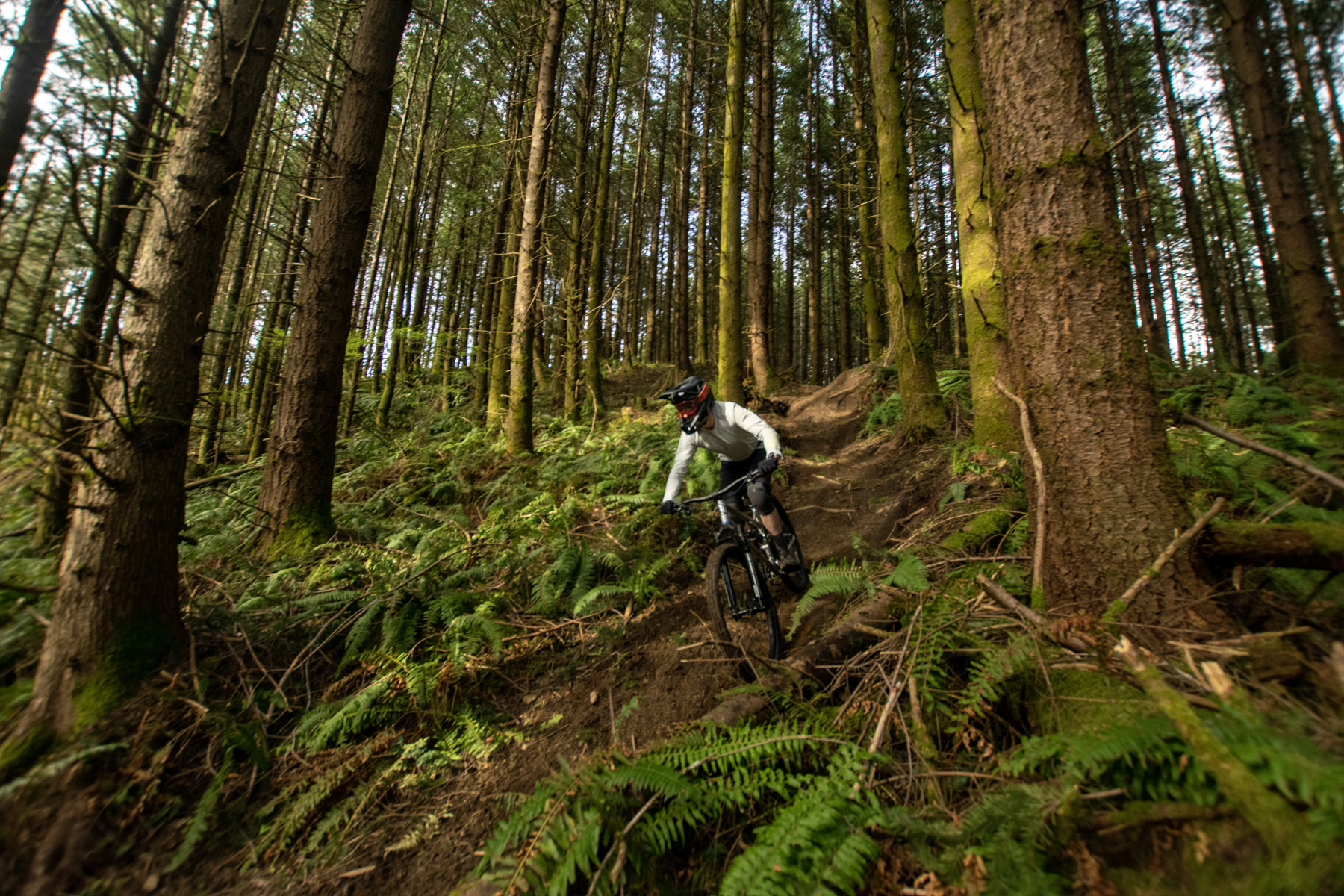
And to be very clear, I don’t think the RocketMAX is especially or unduly lacking in nimbleness, especially accounting for the big C4 size that we’ve been riding. It’s just a long-travel Enduro bike, and one that we sized up on, having been on the brink between the C3 and C4.
The RocketMAX also feels quite a bit more laterally stiff and precise than the Starling Murmur Enduro that I rode earlier this year, for example. They’re both steel bikes, but illustrate really nicely how directly attributing performance attributes to a frame material isn’t very meaningful or accurate. The RocketMAX frame still doesn’t feel wildly stiff, but it’s way, way more so than the Murmur, especially in the rear end, and feels a lot closer to the average for this sort of big Enduro bike than a major outlier in either direction. Of course, it’s not like seeking maximum stiffness is even necessarily a sensible goal; there’s a reason why some DH race bikes, like the Commencal Supreme V5 that just showed up for review, have implemented bolt-on braces of varying stiffness to tune the ride characteristics. But if you’re put off the RocketMAX out of worries that it’ll be a noodle, I’d quell those fears. It’s a really nice-riding, well-rounded frame, and I never felt like it was notably wanting for stiffness or precision in my time on it.
The Build
David: Cotic’s builds are highly customizable to your preferences and needs — which I’m a huge fan of — so I won’t go too deep on the exact details of our build. I really like the thinking behind the spec that Cotic put together for us, prioritizing suspension first and foremost while going solid but fairly affordable pretty much everywhere else. The WTB Verdict front / Trail Boss rear tire combo isn’t my personal favorite (there’s not a tire combination in the world that everyone likes) and I swapped those out for the Continental Kryptotal DH Super Soft paring that has become my personal go-to for varied (i.e., not ultra-wet) conditions on more gravity-oriented bikes for most of my time on the RocketMAX. Otherwise, I got along quite well with the parts spec, especially relative to the overall price.
While I really liked its performance, the Cane Creek Kitsuma Coil shock did inhale a bunch of air part way through our testing and needed a service more quickly than one would hope for. We haven’t ridden enough of those to have much of a sense of whether that mishap was a bit of bad luck or part of a bigger pattern, so I won’t speculate further; I swapped in a RockShox Super Deluxe Air to keep the bike rolling, and that also felt like a good match for the RocketMAX, albeit with a bit less initial sensitivity and traction than the Cane Creek. The RocketMAX’s suspension feels solidly but not wildly progressive, in a range where running either an air or coil shock feels perfectly reasonable, with the typical tradeoffs between the two at play. I’d personally be inclined to spec a coil myself — the RocketMAX’s overall ride is just so smooth and supple-feeling, and a coil shock helped put that over the top — but if you’d like a little more liveliness from the rear end, an air one is plenty viable.
It’s also worth noting that dropper post insertion is a little bit limited on the RocketMAX, due to the rocker link pivot piercing the seat tube. I was able to just barely squeeze a 210 mm OneUp post in for my 785 mm seat height once I reassembled it to reorient the cable port to better line up with where the dropper cable popped up past the rocker pivot. (In the default orientation on our particular post, it kinked the housing too badly to work at full travel, but by reclocking the lower tube I was able to find a configuration that worked for me.) Zack, with his shorter inseam, needed a 185 mm Bike Yoke Revive swapped in. And while the seat tube on the C4 frame that we tested is rather long, going down to the C3 wouldn’t have helped matters — the limitation is the placement of the rocker pivot, which is the same across all frame sizes, so we just would have had more exposed seatpost with the same end result, had we sized down. Cotic has a helpful dropper fitment guide on their site and I was still able to run plenty of dropper post, but it’s worth having a look if you’re concerned.

Zack: I agree with David on the parts spec being sensible and solid, especially compared to a number of other larger brands that will often spec low-end suspension and mid-tier drivetrain parts. I also don’t totally love the WTB tire combo; I find the Verdict to be a bit vague in firmer conditions, but it does grip well when the dirt is wet and soft. The Trail Boss rolls quickly but I found it to struggle for traction in most scenarios outside of truly groomed trails. It was nice to see the quality Hope headset — clearly not an afterthought like headsets often are with stock builds — and the Magura MT5 brakes stood out for their consistent feel and power, though the Shimano I-Spec adapter was a total pain and didn’t allow much flexibility in shifter position relative to the brake lever.
It’s worth calling out that the frame hardware does have a slightly homegrown feel to it. There’s a mix of hardware colors and shapes, and the bolts at the seatstay pivot in particular stick out a bit unnaturally from the frame. Cotic likely doesn’t have the scale to warrant investment in fully custom hardware, but there’s room for aesthetic refinement in further iterations.
Comparisons
David: With the slight caveat that we haven’t ridden the V2 Gnarvana (which shares its front triangle, geometry, and suspension kinematics with the V1 that we tested, and really only differs in the structural details of the rear end), this is the best comparison I’ve got for the RocketMAX. They’re both quite stable, planted Enduro bikes first and foremost, but ones that don’t need to be pushed wildly hard to come alive; they feel especially smooth and comfortable in their ride quality (the RocketMAX even more so); they generally work best with a fairly neutral stance and a more upright body position; and they’re on the slightly more active and grippy / less ultra-efficient end of the spectrum when it comes to pedaling performance.
The S3 Gnarvana that I rode is a lot smaller than the C4 RocketMAX (and, frankly, the latter fit me better), and the RocketMAX does feel more stable at speed but less nimble in tight spots, I think largely due to the sizing differences. I appreciated the extra room to move around on the C4 RocketMAX and the bigger sweet spot that the roomier fit offered, but really do think that’s more down to sizing than anything more inherent to the bikes. The S3 Guerrilla Gravity frame fits me great when configured as a Trail Pistol or Smash, but I’d be tempted to size up to the S4 on the Gnarvana.
Zack: These two are quite different. The Capra has a much softer, more forgiving suspension to it, but the version we tested also had RockShox’s Flight Attendant system, which lent a lot of pedaling efficiency. It’s an easy bike to get along with even on mellower terrain compared to the RocketMAX, but really loses ground to the Cotic when it comes to descending performance on rough and fast trails.
David: I generally agree with Zack in the ways that the Capra and RocketMAX differ, but my take is that the differences aren’t as wide as he’s making out. The Capra is more plush and cushy in its suspension performance and doesn’t pedal as efficiently as the RocketMAX (at least once you take the RockShox Flight Attendant suspension that we tested on the Capra out of the picture). The RocketMAX is more stable and composed when you start pushing it harder, but I don’t think they’re totally unreasonable to cross-shop against each other. If you like the sound of the RocketMAX but want something more nimble and more plush feeling at lower speeds (and are okay with a drop-off in pedaling efficiency), the Capra would be a good call; if you’re intrigued by the Capra but want something that pedals a little better and/or has a slightly higher top end to be pushed quite hard, the RocketMAX merits a look.
It’s also worth noting that we’ve only ridden the 29er version of the Capra, and our comparison here is in relation to that one. Between the smaller rear wheel and considerably shorter chainstays, we’d expect the Capra MX to both handle significantly differently and favor a more forward body position with a lot more weight over the front end, but haven’t ridden one to confirm.
David: Pretty different. The Firebird feels like a more focused, game-on race bike that’s less interested in being ridden passively than the RocketMAX. That’s not to say that the RocketMAX is less bike — if anything, it’s a bit more stable at speed, and it’s definitely more forgiving at the limit — but the Firebird is sharper handling at speed, a bit more nimble in tight spots, and its suspension feels firmer and transmits more feedback to the rider, especially when it’s being ridden at less than maximum attack.
Despite all that, the two are pretty close in terms of pedaling efficiency, and the RocketMAX is definitely the smoother, more comfortable bike at speed on rougher trails. The Firebird has a clear edge when it comes to agility in tight, janky sections but the RocketMAX is an easier bike to ride fast on steep, rough trails and doesn’t require as much precision to get the most out of it.
David: The SB160 is something like a slightly more stable, fractionally less agile, more efficient-pedaling version of the Firebird, so it’s also a more dedicatedly game-on bike than the RocketMAX (but again, the RocketMAX can absolutely be ridden very hard on properly burly trails — it just doesn’t demand it). The RocketMAX also works best with a somewhat more neutral, centered body position, whereas the SB160 prefers a more forward, aggressive stance with more weight over the front end.
Zack: Earlier in the review we hinted at the RocketMAX being a bit less of a versatile all-arounder than some others in the category, and the Rallon is one of those bikes we were referring to. The Rallon is quite efficient and notably snappy when changing direction, aided by its steeper head angle. The RocketMAX is a less fatiguing bike to ride in rough and steep terrain. The Rallon could easily be my quiver of one, whereas the RocketMAX might be a bit much on mellow or long-distance rides.
David: Yup. Of the bikes I’ve tested, the Rallon is maybe the best example of an Enduro bike that you can push quite hard (if you’re riding it fairly precisely and actively) that also still maintains a lot of all-around Trail bike versatility. It’s sharper handling (but less stable at speed) than the RocketMAX, pedals more efficiently (but gives up traction under power and isn’t as plush over smaller bumps or composed in super rough terrain), and generally feels like “less” bike overall.
David: The Megatower isn’t that wildly different from the RocketMAX in most individual aspects, but it’s a case where a lot of smaller differences add up to a pretty different whole. They’re both bikes that are on the more plush and planted end of the spectrum without feeling unsupportive or coming undone when you start pushing them harder in steeper, rougher terrain, but the RocketMAX is the more stable of the two at speed. And while the gap isn’t a big one, the RocketMAX probably has a slight edge in terms of pedaling efficiency over the Megatower.
Once again, the fit is also a real part of the picture. The Megatower was one of the main bikes I had in mind when I mentioned having been on the cusp between the Large and XL frame, and I suspect that I’d have been better off on the XL Megatower over the Large frame that I rode (and that Dylan Wood, who’s a little shorter than me, really clicked with).
David: The Nomad bears a strong family resemblance to the Megatower, but is a little more nimble and correspondingly less stable at speed, and favors a slightly more centered body position than the Megatower. In total, it’s a more agile bike and one that’s not as stable at speed, while being easier to throw around in the air and generally ride a bit more playfully as opposed to just being focused on going fast.
(Also, the same stuff I said about sizing on the Megatower mostly applies here too, though the more rearward body position favored by the Nomad does make it feel a little bigger, or maybe more accurately like sizing down is a better fit for the character of the bike.)
David: Super different. Despite a nearly-as-long reach (495 mm) as the C4 RocketMAX, the Medium G1 feels a lot more compact both in terms of seated and standing cockpit length, due to the combination of a much steeper seat tube angle and much shorter stack height, the latter of which brings the effective reach back substantially once you account for the considerable stack of headset spacers I need to run to get the cockpit setup I’m after.
But despite feeling more compact in terms of the cockpit / fit, the G1 is a little more stable than the RocketMAX, not as nimble in tight spots, and also requires a more forward stance with more weight over the front end. The G1 pedals quite a bit more efficiently, but gives up some traction under power to get there, and while its suspension is quite good overall, it’s not as smooth and plush as the RocketMAX, especially when you’re going less than flat out.
David: They’re both British and (mostly) steel, but that’s about it. The RocketMAX is a bigger, more stable bike that needs more speed and bigger terrain to come alive than the Murmur, but is more composed and confidence-inspiring once you get there. It’s also a lot stiffer and more precise in terms of its frame flex, and the suspension feels more “normal” (whereas the very flat leverage curve of the Murmur contributes to its overall ride quality in a big way — check out our full review for more on that). Despite having a good bit more suspension travel, the RocketMAX is actually pretty close to the Murmur in terms of pedaling efficiency, but if anything is a notch behind it in terms of traction under power, where the Murmur really excels.
David: This one’s interesting. Both the RocketMAX and the VHP16 are 160mm-travel Enduro bikes that do an especially good job of being both easygoing and able to be pushed quite hard, and both feature excellent suspension performance, but they’re otherwise quite different. For starters, the RocketMAX is way more stable at speed but less nimble and playful at lower speeds and in tighter spots than the VHP16. The VHP16 also pedals quite a bit more efficiently.
Both bikes are really good calls for certain folks who want a bike that they can ride quite hard on burly trails but is still engaging and fun when they’re not charging. But the delineation between them is easy: the more you want a bike that’s ultra-forgiving of mistakes and makes riding gnarly trails (relatively) easy, the more sense the RocketMAX makes, so long as you’re willing to sacrifice some mellower Trail-bike versatility to get there. The VHP16 is more fun on flatter, tighter trails where you’re not able to carry as much speed, is easier to throw around in the air, and otherwise ride with a more playful, freeride-oriented approach.
David: The Range is more stable and composed at speed than the RocketMAX, is less nimble in tighter spots, pedals less efficiently, and generally feels like the best approximation of a DH bike that you can still sort of pedal that I’ve ridden to date. The RocketMAX is very much a big, burly bike but it’s still a lot more versatile than the Range and is more engaging at lower speeds. The Range is kind of a one-trick pony (and is incredibly good at what it does for that specificity) but the RocketMAX is a far better all-rounder.
Specialized Enduro
Zack: These are both big, stable bikes, but they go about things differently. The Enduro has a notably deep-feeling rear suspension, paired with a stiff and responsive chassis, whereas the RocketMAX seems to ride a bit higher in its travel but with a calmer, more damp-feeling frame characteristic. The Enduro pedals better and may be more versatile in the end despite its 170 mm of travel, but the RocketMAX has the edge in being slightly more composed when riding at the limit.
Zack: Similar ride feel, different geometry. The Titan has even longer chainstays at 452 mm but a much shorter reach at just 470 mm (for the Large frame I tested), and the head angle is more conservative at 64.5 degrees. As a result, the Titan feels more upright than the RocketMAX, but it also pedals slightly better and is a bit more fun on mellower trails. The slacker and much longer RocketMAX has a calmer demeanor at speed, but is less responsive. Both bikes have notably effective suspension and have a forgiving, damp feel.
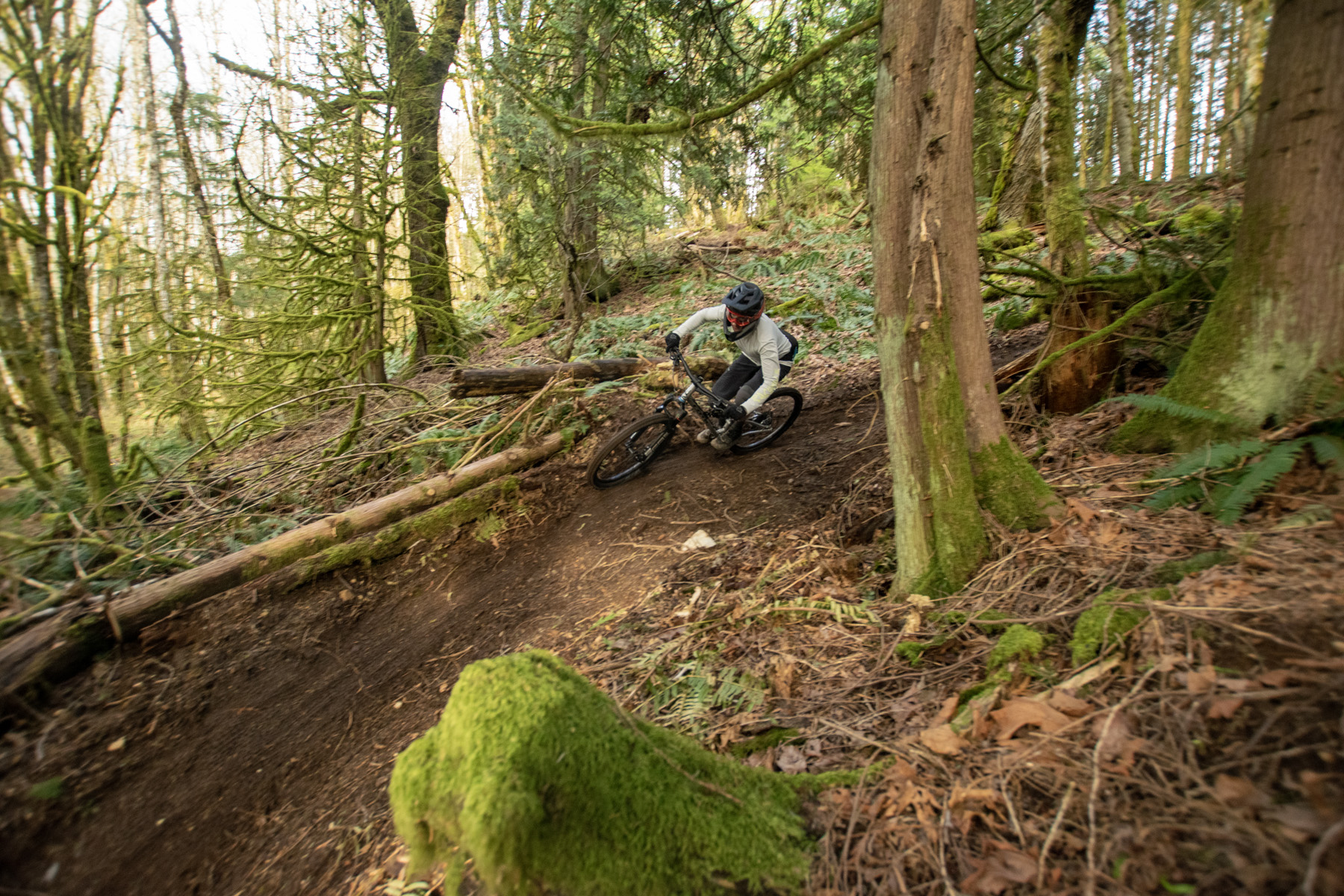
Who’s It For?
The Cotic RocketMAX is one of the smoothest-riding, most comfortable Enduro bikes we’ve been on in a while, and it’s a really good option for folks who want a properly big, burly bike, but one that doesn’t demand that it be ridden super aggressively and precisely at all times. There are ultra-precise, game-on Enduro race bikes that are sharper handling and more agile when making adjustments at speed, but they tend to also be less forgiving than the RocketMAX when you’re making mistakes or otherwise riding more tentatively. The job the RocketMAX does of being approachable and easygoing, while still being able to also go very hard when you want to, is genuinely impressive.
Folks who know they prefer a very steep seat tube angle might find the RocketMAX’s to be a little moderate for their taste, and it’d be nice if the seatpost insertion went deeper. But despite its less-common frame material and not-super-flashy construction, the RocketMAX is just a well-sorted, well-rounded bike, rather than something that feels like a quirky, niche offering for folks who want something emphatically different.
Bottom Line
Steel full-suspension bikes are making a bit of a comeback (and we’ve got a couple more on the way for reviews — stay tuned), but Cotic has been well ahead of the curve on that front, and the RocketMAX makes a compelling case for why. It’s a beautifully smooth-riding, quiet bike, with nicely sorted geometry and suspension to go with it, and between that and Cotic’s flexible and affordable builds, it’s a bike that we can imagine a lot of folks who genuinely have use for a burly 160mm-travel Enduro bike getting along with quite well.

